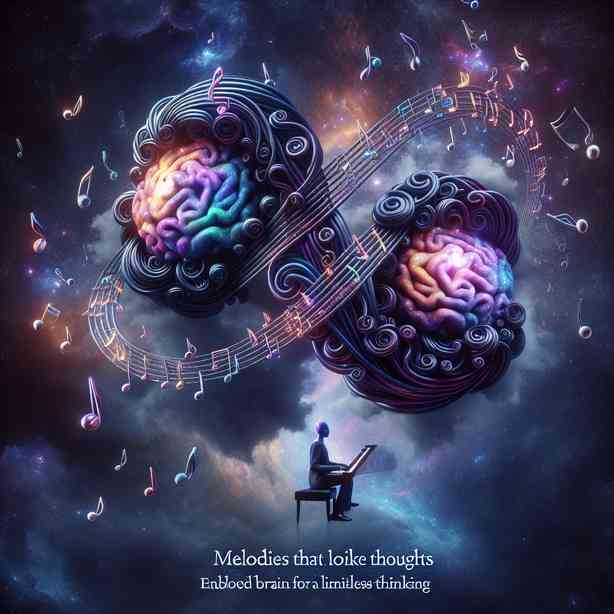
Melodies that loop like thoughts encapsulate a fascinating intersection of music, psychology, and human experience. The relationship between melodies and thoughts is profound, revealing how both can create cyclical patterns in our minds. Music has the ability to resonate deeply within us, sometimes echoing our internal dialogues and thoughts. This phenomenon is not just a fleeting observation; it is a rich area of exploration for both creators and listeners alike.
Music, particularly melodic loops, can trigger a variety of emotional responses. These repetitive musical patterns often mirror the way our thoughts can cycle through similar themes and feelings. Perhaps you’ve experienced a particular song getting stuck in your head, playing back on an endless loop, reminiscent of how certain thoughts persistently resurface in our minds. This connection highlights the powerful role that melodies play not only as a form of entertainment but as a reflection of our inner experiences.
Neuroscientifically, our brains are wired to respond to repetitive stimuli. When we engage with music that features loops, our brains release dopamine—often referred to as the “feel-good” neurotransmitter. This release leads to both enjoyment and a sense of reward, reinforcing our experience with the music. Similarly, when we think, our brains build associations. The looping nature of melodies evokes familiarity, enabling us to engage in an almost meditative state. When we recognize a melody, our brains respond with a sense of nostalgia or comfort, creating a positive feedback loop that mirrors our thought patterns.
Moreover, melodies can act as triggers for memories, transporting us back to specific moments in our lives. Just as certain thoughts may loop due to their emotional weight or significance, music can evoke similar feelings and recollections. This connection can be powerful; a simple melody may bring forth vivid images from our past, similar to how a thought can spiral into the recollection of experiences that shape our reality. The looping nature of melodies allows us to explore our emotional landscapes, making music a profound tool for introspection.
For many, engaging with music creates a therapeutic space, allowing them to process emotions that loop in their minds. This aspect is particularly relevant in contemporary discussions around mental health. Music therapy utilizes these looping melodies to help individuals explore their feelings and develop coping mechanisms. By understanding the relationship between looping thoughts and melodies, we can harness music’s potential to assist in emotional healing and self-discovery. Just as certain thoughts can lead to breakthroughs or realizations, so can listening to a carefully chosen piece of music.
In addition to personal healing, melodies that loop can foster community and connection. Music has always had a communal aspect, bringing people together through shared experiences. When individuals resonate with a tune that mirrors their looping thoughts or emotions, it creates an opportunity for dialogue and understanding. Shared musical experiences can foster empathy, as we recognize the commonality in our human experiences. This is significant in an increasingly fragmented world, where connection often feels elusive.
Exploring the global landscape of music reveals how different cultures utilize looping melodies to express their narratives. In various traditions, repetitive musical forms are deeply embedded in ritualistic practices and storytelling. These loops serve not only to entertain but also to communicate values, beliefs, and shared histories. The cyclical patterns in these musical forms echo the cyclical nature of life itself, demonstrating how music transcends boundaries and resonates with the human experience universally.
Furthermore, technology has transformed the way we interact with looping melodies. In the digital age, music loops are more accessible than ever, from streaming services to music production software. These advancements enable not only consumption but also creation, allowing individuals to explore their creativity and express their own looping thoughts through music. This democratization of music creation invites a wider range of voices and perspectives, enriching the tapestry of musical experiences available to us.
As we delve deeper into the phenomenon of melodies that loop like thoughts, it becomes evident that this relationship is dynamic and multifaceted. Understanding how melodies resonate with our mental processes opens the door for innovative approaches to emotional well-being, creative expression, and communal connection. This exploration is ongoing and contributes significantly to our understanding of the interplay between music and the human psyche.
In contemplating the future, the potential for utilizing melodies for therapeutic and communal purposes continues to grow. As we further explore the intricacies of how music influences our thoughts and feelings, we can develop more effective methods to harness its power. As researchers, musicians, and listeners engage with these concepts, a richer understanding of the significance of melodies in our lives will emerge.
In conclusion, melodies that loop like thoughts reveal a profound connection between music, memory, and emotions. These repetitive patterns resonate with our human experience, echoing the way our thoughts often recur. Through understanding and embracing this connection, we can enhance our emotional well-being, foster community, and celebrate the universal language of music. Whether through personal introspection or shared experiences, the melodies that loop in our minds offer endless opportunities for exploration and connection. Embracing this phenomenon can lead us to a deeper understanding of ourselves and each other, cultivating a more harmonious existence both individually and collectively.


